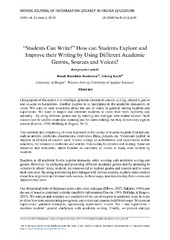| dc.description.abstract | One purpose of this article is to shed light upon the concept of voice in writing, related to genres and sources in humanities. Another purpose is to participate in the academic discussion on voice. We want to raise awareness about the use of voice, in general, among students and supervisors. We want to inspire and motivate students to voice their texts explicitly and naturally – by using different genres and by entering into dialogue with central sources. Such sources can be used to create new meaning and for sense making, but they do not carry a given answer (Dervin, 1999; Holliday & Rogers, 2013). The variation and complexity of voice is present in the variety of sources students find and use, such as articles, textbooks, dissertations, interviews, films, pictures, etc. Voices are explicit or implicit in all kind of sources used. Voices emerge as authoritative and experienced within academia, for instance in textbooks and articles. Voices may be creative and inviting. Some are attractive and believable, others hesitant or uncertain, as voices in many texts written by students. Students, at all academic levels, express insecurity when working with academic writing and genres. However, by analysing and practicing different academic genres and by attending to voice(s) in others’ texts, students are empowered to explore genres and sources and to voice their own texts. By using and entering into dialogue with various sources, students make choices about how to present and interact with sources. In these ways, students develop their voices and improve their texts. Our theoretical point of departure deals with voice, dialogue (Elbow, 2007; Bakhtin, 1986) and the use of sources combined with the search for information (Dervin, 1999; Holliday & Rogers, 2013). We analyse and compare two examples of the use of sources in academic texts, in order to show how texts representing two genres, use voices and sources in different ways. We present supervisors’ guidance strategies, representing supervisors’ voices. We – and supervisors – mention students’ general challenges with academic writing. Finally, we present dialogic strategies and propose a new dialogic strategy. This new strategy combines and unites reading and writing in different genres, drawing on and entering into dialogue with central sources, with different and clear ways of voicing; explicit and implicit voicing. Our dialogic strategy – and other intended dialogic strategies – can be used by students and all supervisors who assist students in writing, when dealing with voice(s) and sources. | en_US |

